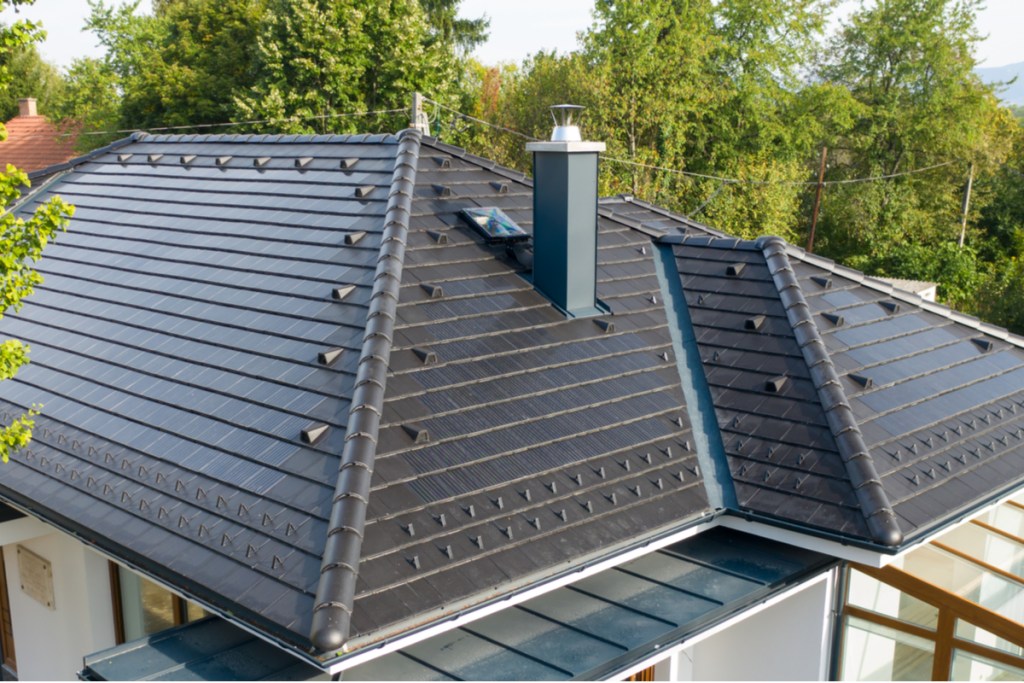Powering homes and businesses with solar power used to be the wave of the future. Today, it’s becoming much more accessible to anyone who wants to reduce their carbon footprint and utility bills.
Developments in recent years have made it possible to forgo the bulky and somewhat unattractive solar panels that sit on top of your roof. Now you can actually construct your roof with solar shingles. Solar shingles have the technical name of building-integrated photovoltaics, or BIPV. They are designed to look like your typical asphalt or slate shingles. However, they perform the additional function of powering your home while also protecting it.
Unless you’re a solar professional, you probably have many questions that you want answers to before you commit to investing in a solar roof.
How much does a solar roof cost?
The first and most critical question that we all want an answer to is: how much will a solar roof cost? The answer, unfortunately, isn’t so simple. Three main factors affect the cost of a solar roof.
Brand and style
Every brand of solar shingle is constructed differently to some degree, and it gives your home a unique aesthetic. The most premium and in-demand brand of roofing shingles is Tesla. The company has developed beautiful quarts roof tiles that come in Tuscan glass, slate glass, textured glass, and smooth glass.
Not only are these tiles attractive, but they’re also durable. If you visit the Tesla website, you’ll see a demonstration video of a hammer shattering clay and slate tiles while it bounces right off the quarts tiles. Telsa’s in-house team comes in and removes your old roof and installs the new one. In the world of solar roofing, a Tesla roof is the most you’ll pay for. According to Forbes, if you have a 200 square foot home, you can expect to pay around $64,000 for a Tesla solar roof.
Coverage
Other solar roofing companies like SunStyle and Luma Solar still replace your existing roof. However, they incorporate active shingles with inactive shingles. This means the entire roof doesn’t require solar tech, resulting in a lower overall cost.
Some companies like CertainTeed produce tiles that can stand alone or be integrated with your existing shingles, so you don’t have to remove old roofing. Although this is a more low-profile method than solar panels, it doesn’t quite have the same curb appeal as a fully integrated solar roof.
You can expect to pay less per square foot with these types of solar roof systems, since you have fewer active solar shingles than the Tesla system. Still, they aren’t cheap. Estimates range between $21 and $25 per square foot for these types of solar roofs. So for a 2,000 square foot home, expect to pay between $42,000 and $50,000.
Federal and state incentives
Solar power is now being incentivized across the country through tax credits, grants, and special financing programs. Some states like California are mandating that new homes incorporate certain levels of solar energy. After state and federal solar incentives, your end cost of a new solar roof might be closer to a standard roof than you might think.

Can a solar roof power a house?
A solar roof can definitely power a home. Still, you’ll want to consider the size and average amount of power your house draws per month. The direction your home faces, the amount of daily direct sunlight it gets, and your geographic location are all additional considerations regarding how many solar shingles you might need. It’s essential to consult with a solar roofing professional to determine if solar can fully power your home.
Pros of solar roofing
Solar roofing is an excellent option to make your home more green, especially if you require a new roof, to begin with. The following are all benefits of choosing a solar roof.
- Although the initial investment is still high, solar power is cheaper than ever, especially with the many incentives.
- Unlike most home improvements, solar gives you a continuous return on investment. In most cases, solar roofs pay for themselves after 6 to 10 years, and then they continue to save you money.
- Some consider solar roofs more visually pleasing, adding curb appeal to your home.
- According to energy.gov, home buyers are willing to pay a premium of up to $15,000 with homes equipped with solar.
- They’re more durable than your standard asphalt shingles, and most solar roofs come with 20- to 30-year warranties.
- They significantly reduce your home’s carbon footprint and help combat climate change.
Cons of solar roofing
With all the benefits of a solar roof, there are still some cons to consider.
- There are high upfront costs, even with incentives.
- Solar roofs work best in direct sunlight. If you live in a state more known for snow than the sun, it will take longer to recoup your upfront investment.
- Like the manufacturing of most products, producing solar shingles impacts the environment.
- Your state might not provide as many incentives for solar energy.
- There may not be a solar roof dealer or installer in your area.
The takeaway
Although solar energy is cheaper than ever, it’s still not the most affordable option. If given the opportunity, it’s reasonable to assume most people would opt for a roofing system that pays for itself over time in energy costs. It’s more than likely solar roofing costs will decrease as technology gets better and competition in the solar industry gets fiercer.
However, battling climate change doesn’t afford you the luxury of waiting for a cheaper solution. If a green home is something important to you, then now is as good a time as any to invest in a solar roof.




